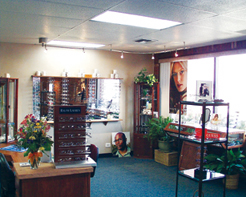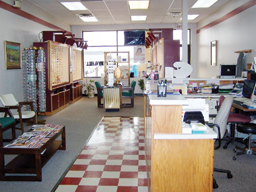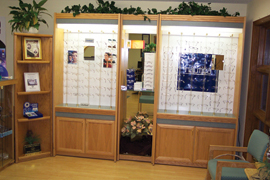Optometrist Elisa Perreault literally started out in the basement and worked her way up. Six-and-a-half years ago, Dr. Perreault purchased a practice in the lower level of a professional building, in downtown Albany, N.Y.
The problem: We didnt have any windows, and no one really knew where we were, she says.
So a little more than three years ago, Dr. Perreault moved her office to the ground floor and did some remodeling, in which she improved the lighting on the mirrors and displays. Its made a big difference, she says.
The difference is to the tune of an extra $50,000 in annual gross revenues. Not bad when you consider that frames, lenses and contact lenses make up an estimated 79.5% of a practices total annual revenue, according to research from Jobson Optical Group.
Are you looking for the kind of success Dr. Perreault and others have had? Well, if you follow these eight suggestions, youll get there in no time.
1. Personalized Service

Featuring specialty lines like Ralph Lauren (above) attracts the consumer.
Educate your patients with a personal touch. [Patients] need to start with understanding that we are here for their best interests and the health of their eyes, says Jill S. Anderson, O.D., of Pensacola, Fla. Dr. Anderson asks each patient what they like and dont like about their glasses. Then, we let them know how we can address their needs, she says. If you educate the patient about how the glasses will fit their needs, theyll find a way to pay for it. Its all perceived value.
Optometrist Richard Annis, of Douglas, Mich., says he tries to avoid the appearance of a sales pitch. Its always, heres a way that we can better your life that we werent able to do before. And people are really receptive to that, he says.
An added tool for personalized service: face-fitting and color charts. When a patient needs glasses, ask them if they would mind you picking out four or five frames to enhance the beauty of their face, suggests Denver practice management consultant John Gay, who has a Doctorate in business. Then, take them to the chart(s) and show them how the pairs work for them. This way, patients perceive an extra level of personal service.
2. Knowledgeable and Friendly Staff
Without knowledgeable, professional and friendly opticians, your dispensary will not be successful. My optician usually explains to every patient what they are looking for in the proper fit of their frames, says David Friedman, O.D., of Westford, Mass. By doing this, the patient wonders if theyre going to get the same kind of attention elsewhere.
Staff training is also essential. You can do the best exam in the area, but if you dont know how to edge and adjust, and therefore train your people how to do it, the lenses will fall out, and youll be thought of as just awful, Mr. Gay says. You have to have your staff properly trained to fit or adjust the glasses to the face, and they should also be trained in professional selling skillslearning skills in order to better the sale. There are several frame reps who can come in and do this.

Putting your dispensary in your reception area allows your patients to browse.
Finally, you need to make sure that you have enough employees in your dispensary says Robert Brooks, O.D., of Greenup, Ky. His dispensary was understaffed, so his employees didnt have enough time to discuss add-ons, second pairs and other options that might have somehow benefited the patient. The right amount of staff is crucial, if you want to have a successful dispensary, he says.
3. Your Own Lab
Richard Cross, O.D., of Boulder, Colo., says it is paramount to be able to edge lenses in your own office, especially if you participate in many third-party plans. For the most part, there is a significant difference from what you will have to pay a lab vs. what you can do yourself, if you can edge the finished lens in your office.
And you should improve your own skills, so that you can then teach your employees.
4. Location, Location, Location
Like Dr. Perreault, optometrist Kimberly Smith, of Danville, Ky., believes that the location of her dispensary has, in part, led to an increase in margins and revenues. Our dispensary is in the front of our office, and I think that having it available as the patient waits or comes in to make an appointment probably does help.
Dr. Smith believes that patients who receive their exam and purchase eyewear at her office probably do so because again, theyve already looked at the frames while waiting to see her.
5. Presentation
The look of your dispensary should correlate with your practice location, Dr. Brooks says. For example, Dr. Brooks practices in a middle-class area. In certain environments, the gold and glitter would be what you would want, he says. But in my case, I went with oak, which is very attractive, but doesnt look flashy [so that] people would shy away from it.
Still, you want to separate the medical and optical portions of your practice. The dispensary shouldnt have a sterile look to it, Dr. Brooks says. His dispensary showcases pictures of models wearing eye wear, so that it has more of a retail feel, and my patients are seeing fashion.
6. Frame Display
We worked on lighting and how we group our frames, so we try to keep a certain look together, Dr. Brooks says. So if youre doing a retro look, then you have a wide array of the retro group grouped together. This way, people can see that they dont have to hunt around for the style they want.
Similarly, J. Gordon Butterfield, O.D., of Versailles, Ky., says that mothers very often bring their children with them, so he placed childrens eyewear alongside the womens collection. This way, while the mom is looking at frames, she is also made aware that if the child should need glasses, an array of options are also available.
7. Competitive Pricing

Proper lighting and grouped frames make a big difference.
You will want to offer a choice of quality inexpensive frames. Be aware, however: All of the frames tend to look alike whether youre in my office or you go down the street, Dr. Friedman says. So I always try to keep one or two unique specialty lines.
You can also dispel perceptions of overpricing by offering a large differential, Mr. Gay says. For example, there should be an economy board for frames in the $49-$89 price range, displays of higher-end frames as well as mid-priced frames.
One last tool that can help: discount packages. Dr. Friedman says that having discount packages prevents patients from going elsewhere, and patients sometimes use these packages to buy second pairs of glasses.
8. No Middle Man
Make arrangements to purchase eyewear directly from the manufacturer, because a lot of times, the distributors enjoy more of the discount, Dr. Cross says. And usually, the manufacturers will give you the discount that they would have given the distributor. So all youre doing with the distributor, a lot of times, is just reducing your discount.
Consider forming a purchasing cooperative. Dont confuse this with buying groups. A buying group will get a discount for the doctors because they buy in volume, but its also important to remember that buying groups tend to have deals with various distributors, so youre probably not going to get the best deal, Dr. Cross says. With purchasing cooperativesa group of doctors ordering togetherhowever, you may be able to obtain your product at a better discount than both the buying group and insurance companies, because theres no middleman.
With a slow-to-recover economy and a growing number of optometric practices and optical chains, competition is fiercer than ever. But by following the above tips, youll surely rise to the top in no time, or at least out of the basement.

